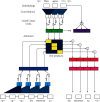A Comprehensive Survey of Abstractive Text Summarization Based on Deep Learning
- PMID: 35958768
- PMCID: PMC9359827
- DOI: 10.1155/2022/7132226
A Comprehensive Survey of Abstractive Text Summarization Based on Deep Learning
Abstract
With the rapid development of the Internet, the massive amount of web textual data has grown exponentially, which has brought considerable challenges to downstream tasks, such as document management, text classification, and information retrieval. Automatic text summarization (ATS) is becoming an extremely important means to solve this problem. The core of ATS is to mine the gist of the original text and automatically generate a concise and readable summary. Recently, to better balance and develop these two aspects, deep learning (DL)-based abstractive summarization models have been developed. At present, for ATS tasks, almost all state-of-the-art (SOTA) models are based on DL architecture. However, a comprehensive literature survey is still lacking in the field of DL-based abstractive text summarization. To fill this gap, this paper provides researchers with a comprehensive survey of DL-based abstractive summarization. We first give an overview of abstractive summarization and DL. Then, we summarize several typical frameworks of abstractive summarization. After that, we also give a comparison of several popular datasets that are commonly used for training, validation, and testing. We further analyze the performance of several typical abstractive summarization systems on common datasets. Finally, we highlight some open challenges in the abstractive summarization task and outline some future research trends. We hope that these explorations will provide researchers with new insights into DL-based abstractive summarization.
Copyright © 2022 Mengli Zhang et al.
Conflict of interest statement
The authors declare that there are no conflicts of interest regarding the publication of this paper.
Figures














Similar articles
-
Abstractive text summarization of low-resourced languages using deep learning.PeerJ Comput Sci. 2023 Jan 13;9:e1176. doi: 10.7717/peerj-cs.1176. eCollection 2023. PeerJ Comput Sci. 2023. PMID: 37346684 Free PMC article.
-
A data package for abstractive opinion summarization, title generation, and rating-based sentiment prediction for airline reviews.Data Brief. 2023 Sep 1;50:109535. doi: 10.1016/j.dib.2023.109535. eCollection 2023 Oct. Data Brief. 2023. PMID: 37720686 Free PMC article.
-
Abstractive Arabic Text Summarization Based on Deep Learning.Comput Intell Neurosci. 2022 Jan 11;2022:1566890. doi: 10.1155/2022/1566890. eCollection 2022. Comput Intell Neurosci. 2022. PMID: 35069714 Free PMC article.
-
Integrating domain knowledge for biomedical text analysis into deep learning: A survey.J Biomed Inform. 2023 Jul;143:104418. doi: 10.1016/j.jbi.2023.104418. Epub 2023 Jun 7. J Biomed Inform. 2023. PMID: 37290540 Review.
-
Patient Information Summarization in Clinical Settings: Scoping Review.JMIR Med Inform. 2023 Nov 28;11:e44639. doi: 10.2196/44639. JMIR Med Inform. 2023. PMID: 38015588 Free PMC article.
Cited by
-
Information Capsule: A New Approach for Summarizing Medical Information.Int J Prev Med. 2024 Oct 18;15:52. doi: 10.4103/ijpvm.ijpvm_254_23. eCollection 2024. Int J Prev Med. 2024. PMID: 39539581 Free PMC article.
-
Brain-model neural similarity reveals abstractive summarization performance.Sci Rep. 2025 Jan 2;15(1):370. doi: 10.1038/s41598-024-84530-w. Sci Rep. 2025. PMID: 39747634 Free PMC article.
-
Research on automatic pilot repetition generation method based on deep reinforcement learning.Front Neurorobot. 2023 Oct 11;17:1285831. doi: 10.3389/fnbot.2023.1285831. eCollection 2023. Front Neurorobot. 2023. PMID: 37885770 Free PMC article.
-
Generative AI Models in Time-Varying Biomedical Data: Scoping Review.J Med Internet Res. 2025 Mar 10;27:e59792. doi: 10.2196/59792. J Med Internet Res. 2025. PMID: 40063929 Free PMC article.
-
Evaluation of a Digital Scribe: Conversation Summarization for Emergency Department Consultation Calls.Appl Clin Inform. 2024 May 15;15(3):600-11. doi: 10.1055/a-2327-4121. Online ahead of print. Appl Clin Inform. 2024. PMID: 38749477 Free PMC article.
References
-
- Vilca G. C. V., Cabezudo M. A. S. A study of abstractive summarization using semantic representations and discourse level information. Text, Speech, and Dialogue . 2017:482–490. doi: 10.1007/978-3-319-64206-2_54. - DOI
-
- El-Kassas W. S., Salama C. R., Rafea A. A., Mohamed H. K. Automatic text summarization: a comprehensive survey. Expert Systems with Applications . 2021;165 doi: 10.1016/j.eswa.2020.113679.113679 - DOI
Publication types
MeSH terms
LinkOut - more resources
Full Text Sources
Miscellaneous

